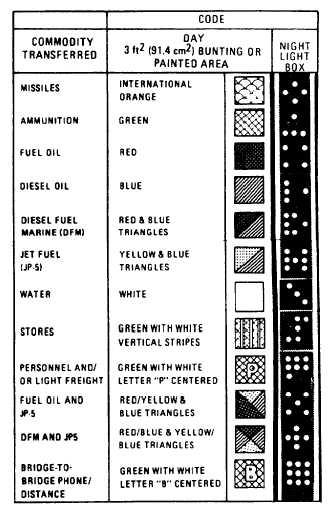| |
normally provides individual telephone lines between
conning stations, either ship may provide station-to-
station phone lines for use between transfer stations.
Talkers must ensure that telephone leads are ready to
establish communications as soon as jackboxes are
received aboard. To prevent injuries resulting from rapid
surging of ships while they are alongside, talkers on the
intership lines do not wear telephone neck straps; the
telephone lines are hand-tended.
Careful attention should be given to the matter of
jackbox covers. They must be secured tightly by
wrapping the phone boxes in plastic bags when the
telephone lines are being passed between ships.
Experience shows that a replenishment-at-sea operation
can be slowed by lack of attention to this small, but vital,
detail. Hand paddle and light signals at replenishment
stations parallel orders passed over the sound-powered
telephones. During daylight, replenishment station
Signalmen render hand signals with 12- by 12-inch
paddles; at night, red, green, and amber flashlights or
colored wands are used.
At each replenishment station both ships indicate
the commodity being handled.
LINE-THROWING GEAR
Line-throwing guns or bolos are used to pass shot
line between ships. Normally, this is done by the
delivery ship except for carriers and other ships with
aircraft on deck. The line-throwing gun fires an
illuminated projectile. The bolo, which is preferred for
passing the shot line in daylight, consists of about 10
ounces of lead with rounded corners. It is well padded,
encased in rubber or leather, and attached to the end of
a nylon shot line. A 2-inch toggle is secured to the line
about 5 feet from the weight. To use the bolo, you must
grasp the toggle and whirl the weight about your head
several times to gain momentum before letting go.
Utmost caution should be exercised when a line-
throwing device is used because of the potential for
possible injuries to personnel. A shot line is returned at
the earliest possible time to facilitate preparation of the
line for another relay, if needed.
Line-throwing gunners and bolo heavers must be
well trained, and they must be outfitted in red helmets
and red jerseys or red vests. Before firing or heaving the
lines, the word is passed on both ships over the 1MC
and/or by electric megaphone (bull horn) as follows:
FIRING SHIP: “ON THE (name of receiving ship),
STAND BY FOR SHOT LINES. ALL HANDS
TOPSIDE TAKE COVER.”
RECEIVING SHIP: “ON THE (name of own ship),
STAND BY FOR SHOT LINES AT (station(s)
concerned). ALL HANDS TOPSIDE TAKE COVER.”
Before firing the shot, each station on the delivering
ship sounds one blast on a whistle. When ready to
receive the shot line, each station on the receiving ship
replies with two blasts. These two signals must be
sounded each time the shot line is fired. The messenger
is the main line used in hauling a rig between ships.
If the delivering ship has difficulty getting its shot
lines across, the receiving ship uses its own line-
throwing guns when requested to do so by the
delivering ship. The shot or bolo lines are used to haul
over the messengers and then passed back at the earliest
convenience to the ship furnishing them.
Replenishment stations are marked according to the
commodity delivered or received. These station
markers are shown in figure 4-26.
Figure 4-26.–Station markers.
4-31
|

